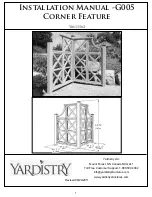
3
SAFETY
WATCH FOR THIS SYMBOL. IT POINTS
OUT IMPORTANT SAFETY
PRECAUTIONS. IT MEANS
“ATTENTION---BECOME ALERT!”
YOUR SAFETY IS INVOLVED.
It is your responsibility as an owner,
operator, or supervisor to know and instruct
everyone using this machine at the time of
initial assignment and at least annually thereafter, of
the proper operation, precautions, and work hazards
which exist in the operation of the machine in
accordance with OSHA regulations.
Safety Is No Acciden
t
The following safety instructions, combined with
common sense, will save your equipment from
needless damage and the operator from
unnecessary exposure to personal hazard. Pay
special attention to the caution notes in the text.
Review this manual at least once each year with
new and/or experienced operators.
1. Read and understand the operator’s manual
before operating this machine. Failure to do
so is considered a misuse of the equipment.
2. Make sure equipment is secure before
operating.
3. Always keep children away from equipment
when operating.
4. Make sure everyone that is not directly
involved with the operation is out of the work
area before beginning the operation.
5. Make sure all safety devices, shields, and
guards are in place and are functional before
beginning the operation.
6. Shut off power to adjust, service, or clean.
7. Keep hands, feet, and clothing away from
moving parts. It is a good idea to remove all
jewelry before starting the operation.
8. Visually inspect the machine periodically
during operation for signs of excessive
vibration, loose fasteners, and unusual
noises.
CAUTION
1. Read and understand
instruction manual before
operating.
2. Keep all safety shields
and devices in place.
3. Make certain everyone is
clear before operating
machine.
4. Keep hands, feet, and
clothing away from
moving parts.
5. Shut off power to adjust,
service, or clean.
6. Make sure machine is
secured before operating.
7. When transporting, shut
fuel lever off.
8. DO NOT operate
machine when guards are
removed.
Pre-Operating Check List
1. Hook up hydraulic hoses. Use thread
tape
only
on
pipe thread
connections.
2. Fill hydraulic oil to level with the upper
hole of the resevoir.
3. Adjust the hydraulic pressure regulator.
4. Purge air from hydraulic cylinder.
5. Service the gas engine and gear
reduction box.
6. Connect the wire harness to the solenoid
switch of the hydraulic system.
7. Check all bearings for proper lubrication.
8. Check the tube for foreign material.
9. Check all belts for proper tension.
10. Re-tighten all setscrews.
11. Start unit and check tender belt
alignment while unit is empty.
12. Do not leave electric toggle switch in the
“ON” position when not in use – will drain
battery.
BELT CARE……..
It is suggested that the unit be run every two to three days or more often if possible. This tends to keep the
tender belt alive and stops any forming of the belt to the curvature of the tube while the unit is not in use.
NOTE: Belt may deteriorate if not in use and exposed to weather conditions for any prolonged period of
time.
Содержание 1310-001
Страница 9: ...9 PARTS IDENTIFICATION...
Страница 10: ...10 PARTS IDENTIFICATION...
Страница 11: ...11 PARTS IDENTIFICATION...
Страница 12: ...12 PARTS IDENTIFICATION...
Страница 13: ...13 PARTS IDENTIFICATION...
Страница 14: ...14 PARTS IDENTIFICATION...
Страница 15: ...15 PARTS IDENTIFICATION...
Страница 16: ...16 PARTS IDENTIFICATION...
Страница 17: ...17 PARTS IDENTIFICATION...
Страница 18: ...18 PARTS IDENTIFICATION...
Страница 19: ...19 PARTS IDENTIFICATION...
Страница 20: ...20 PARTS IDENTIFICATION...
Страница 21: ...21 PARTS IDENTIFICATION...
Страница 22: ...22 PARTS IDENTIFICATION...
Страница 23: ...23 PARTS IDENTIFICATION...
Страница 24: ...24 PARTS IDENTIFICATION...
Страница 25: ...25 PARTS IDENTIFICATION...
Страница 26: ...26 PARTS IDENTIFICATION HYDRAULICS SHOWN ASSEMBLED TO MACHINE...




































